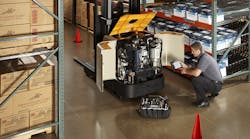As most supply chain executives and warehouse managers know too well, the supply chain—and the warehouse—is awash in data. Not all of it is solely focused on tracking product movement. Warehouse and forklift connectivity is generating data on worker performance, forklift utilization, and the health and status of vital equipment. Companies are investing money and resources to obtain and analyze the data to figure out how best to use it to further increase productivity, lower costs and enhance safety.
One area where greater connectivity is poised to deliver value is forklift fleet service and maintenance. Already, connected service technicians, armed with new technology and increased connectivity, are helping make forklift service calls smarter and more proactive. As more data is gathered on forklift performance and operation, supply chain managers can expect service techs to arrive on-site already understanding the issue and having the right parts to make the repair.
When needed, connected tools, such as mobile tablets or augmented reality wearables, will assist the technician and even walk them through the steps to fix an issue. In addition, the maintenance data from the service call will be uploaded to the service cloud, giving the fleet manager complete visibility to the maintenance issue and repair and further strengthening the service data pool.
As service providers work closely with customers to create a connected service experience, warehouse and supply chain executives are poised to realize a number of important forklift fleet maintenance benefits.
Reduced Downtime
Forklifts are one of the workhorses of the supply chain. When forklifts are not running, products are not moving. A connected service experience will enable facility managers and executives to reduce unplanned downtime and the mean time to repair (MTTR). Monitoring event codes, forklift performance and health data allow them to work with service techs to be more proactive about repairs and recognize symptoms before they become a larger issue that results in downtime.
Service techs can also use the actionable information to ensure they come to the site prepared to address the issue with the right part on hand, shortening MTTR.
Predictive Maintenance
A connected service experience will allow organizations to transition from a reactive service and maintenance program to a more predictive one. This includes the service provider using historical data to help diagnose potential causes of issues before the tech arrives onsite. It also means using that historical data to understand equipment operating trends and schedule service and maintenance to anticipate and eliminate potential issues. If historical data shows a particular part wears out on a forklift after a certain number of operating hours, managers can schedule replacement accordingly.
As forklifts become more connected, service and maintenance programs can utilize software updates and downloads to fix certain issues without a service call.
Hourly-based Planned Maintenance
Currently, most planned maintenance schedules are based on the calendar, aligning equipment maintenance cycles and plotting quarterly, biannual, or annual maintenance shutdown periods. While this method helps reduce downtime, it is often difficult to align all maintenance cycles.
Armed with greater connectivity and actionable data from real-time monitoring of forklift performance, managers can instead align planned maintenance schedules to the business cycle. For instance, if data shows certain forklifts are being operated more during a certain period of time—like the Christmas season—managers can tailor the maintenance schedule to specifically target those trucks to realize a shorter shutdown period.
Visibility into Service Status
With today’s equipment maintenance programs, it can often be difficult to monitor progress once a work order has been issued. Has the service tech been to the site? Is the issue resolved? Is there any follow up needed? A connected service experience provides managers greater visibility during every step of the process.
Through established channels and processes, service providers share relevant information, including when the tech showed up, what the issue was and how it was resolved. This visibility also enables managers to create an informed, planned replacement product lifecycle formula unique to the organization.
Maintenance-by-the-Hour
Finally, a connected experience may change how organizations structure maintenance plans. Supply chain and warehouse managers can design a plan around how they actually use the forklifts. Similar to the power-by-the-hour leasing concept, where customers only pay for the time they used the equipment, maintenance-by-the-hour aligns with an organization’s business model. For some organizations, this concept might be a better option than a flat-rate monthly program. With maintenance-by-the hour, maintenance costs directly correlate with equipment utilization, and maintenance schedules can adapt to peaks and valleys in the business cycle.
As connectivity continues to increase in material handling, forklift manufacturers are working with customers to establish a connected service experience. Creating this experience can help companies realize a number of benefits that will help ensure that their forklift fleet is operational and available when they need it. MH&L
Craig Bruns is vice president-customer support with Crown Equipment Corp., a manufacturer of forklifts.



